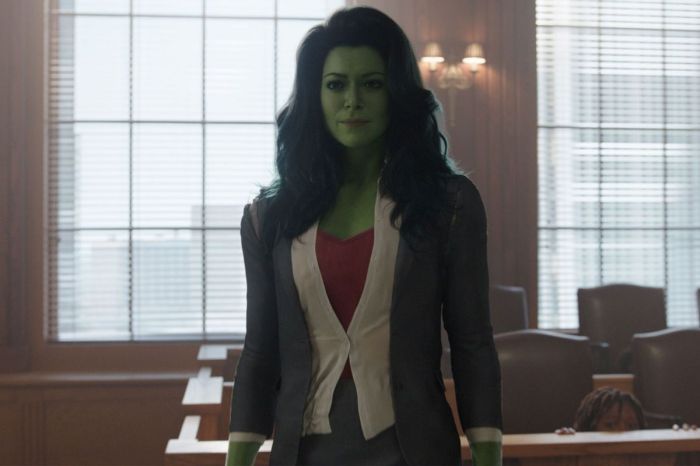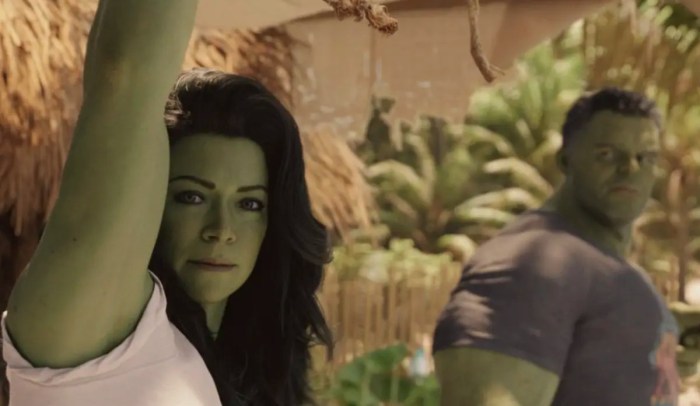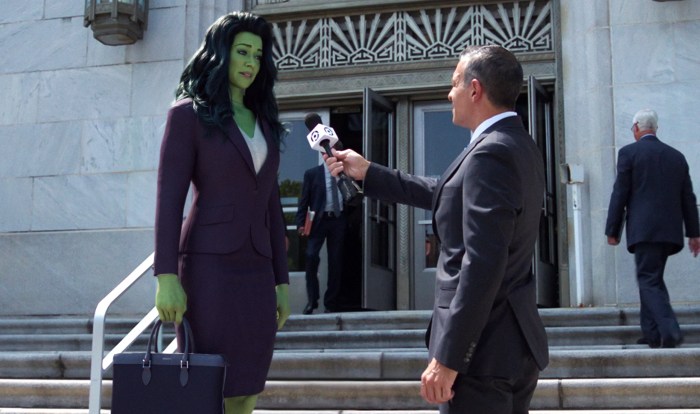She-Hulk: Attorney at Law cleverly weaves a tapestry of Easter eggs, cleverly referencing the broader Marvel Cinematic Universe (MCU), legal intricacies, beloved comic book storylines, and the very nature of superhero narratives. This exploration delves into the numerous hidden gems scattered throughout the series, examining their significance and impact on both the show’s comedic effect and the larger MCU landscape.
From subtle visual cues to overt character cameos, the show masterfully utilizes Easter eggs to enhance viewer engagement and deepen the overall narrative experience. We’ll unpack the show’s legal satire, its meta-commentary on superhero tropes, and its rich connections to the source material, providing a comprehensive analysis of the show’s many layers of hidden meaning.
Marvel Cinematic Universe Connections

She-Hulk: Attorney at Law cleverly weaves itself into the existing fabric of the Marvel Cinematic Universe (MCU), utilizing cameos and references to enrich its narrative and hint at future storylines. The show’s approach, however, often contrasts with the established tone of previous MCU projects, offering a more comedic and self-aware perspective on the superhero world. This unique lens allows for both playful interactions with established characters and the introduction of intriguing new plot threads.
The integration of existing MCU characters serves several crucial functions. It provides context for She-Hulk’s unique position within the MCU, validates her existence within this established universe, and offers opportunities for cross-promotion and expansion of existing narratives. Moreover, the cameos often function as comedic devices, playing with audience expectations and subverting typical superhero tropes. This self-awareness is a defining characteristic of the series and contributes to its overall tone.
MCU Character Cameos and Their Significance
Several established MCU characters make appearances in She-Hulk: Attorney at Law, each contributing to the show’s narrative in distinct ways. Wong, Sorcerer Supreme, appears in multiple episodes, providing legal counsel and showcasing his versatility beyond his role in Doctor Strange. His presence solidifies the connection between the mystical aspects of the MCU and the more grounded legal world of Jennifer Walters. Bruce Banner/Hulk also plays a significant role in introducing Jennifer to her powers and shaping her understanding of her new life. His continued presence, albeit reduced, maintains the link to the Avengers and the larger superhero community. Other cameos, such as Daredevil and Captain America (Sam Wilson), serve to establish connections with other corners of the MCU, adding depth to the established superhero landscape. These appearances not only offer fan service but also organically integrate She-Hulk into the larger MCU narrative.
Comparison of Character Portrayals
The portrayal of established MCU characters in She-Hulk often differs from their previous appearances, primarily due to the show’s comedic tone and meta-narrative elements. Wong, for example, is presented as more approachable and humorous than his portrayal in Doctor Strange, highlighting a different facet of his personality. Similarly, Daredevil’s appearance retains his serious nature but is also infused with a self-aware wit, complementing the overall comedic style of the show. This shift in characterization is deliberate, allowing for a fresh perspective on familiar characters while maintaining their core identities. The contrast between the more serious tone of previous MCU films and the comedic tone of She-Hulk demonstrates the flexibility of these characters and the adaptability of the MCU as a whole. This stylistic contrast highlights the unique narrative space She-Hulk occupies within the larger franchise.
Implications for Future MCU Projects
The cameos in She-Hulk: Attorney at Law create several potential storylines for future MCU projects. Wong’s involvement suggests potential crossovers with future Doctor Strange films or other projects involving the mystical arts. Daredevil’s appearance hints at a continued exploration of his character and potential team-ups with other heroes. The introduction of new characters and legal challenges within the show could also lead to future spin-offs or plotlines in other MCU series.
The comedic, self-aware approach of She-Hulk opens up opportunities for more meta-narrative storytelling within the MCU, potentially influencing the tone and style of future projects.
Timeline of Potential Storylines
The following timeline illustrates potential storylines stemming from She-Hulk’s cameos:
| Timeline Point | Event | Potential Implications |
|---|---|---|
| Short-term (Next 1-2 years) | Wong’s continued involvement in magical disputes alongside Jennifer Walters. Daredevil’s continued solo adventures or team-ups. | Possible appearances in future projects featuring Wong or Daredevil. Potential for a She-Hulk and Daredevil team-up. |
| Mid-term (3-5 years) | She-Hulk’s involvement in larger MCU events, potentially alongside the Avengers or other superhero teams. | Expansion of She-Hulk’s role within the larger MCU narrative. Potential for a She-Hulk-centric film. |
| Long-term (5+ years) | The establishment of She-Hulk as a prominent figure in the MCU, potentially leading to crossovers and collaborations with other heroes across various media. | She-Hulk becomes a key player in future MCU sagas and storylines. |
Legal Profession Easter Eggs
She-Hulk: Attorney at Law cleverly incorporates numerous elements of the real-world legal profession, adding layers of depth and humor to its narrative. These Easter eggs range from specific legal precedents to satirical portrayals of courtroom dynamics and legal procedure. The show’s creators successfully blend legal realism with comedic exaggeration, creating a unique viewing experience for both legal professionals and casual viewers.
Real-World Legal Precedents and Terminology
The series frequently references and subtly incorporates aspects of real-world legal cases and terminology. For instance, the show’s focus on superhero-related legal issues mirrors the growing field of entertainment law, dealing with intellectual property rights, contracts, and celebrity endorsements. The complexities of these legal issues, often simplified for the viewer’s understanding, are nonetheless rooted in actual legal principles. The show also touches upon concepts like defamation, negligence, and the burden of proof, all of which are fundamental to legal practice. While specific case names aren’t explicitly mentioned, the legal challenges presented to Jennifer Walters echo real-world scenarios involving high-profile individuals and their legal battles. The show’s depiction of courtroom proceedings, though often comedically exaggerated, generally adheres to the basic structure and procedures of a real courtroom.
Examples of Legal Humor and Satire
The show employs various comedic techniques to satirize aspects of the legal profession.
Courtroom Drama Satire
The courtroom scenes often exaggerate the theatrics and posturing commonly associated with high-stakes legal battles. The over-the-top performances of opposing counsel, the dramatic reveals of evidence, and the intense focus on courtroom strategy all contribute to the comedic effect. This exaggeration serves to highlight the sometimes-absurd nature of legal proceedings, particularly in highly publicized cases.
Procedural Comedy
The show’s depiction of the daily grind of legal work, including paperwork, client meetings, and the general bureaucratic hurdles faced by lawyers, is a source of much of its humor. The show portrays the often-tedious aspects of legal practice in a lighthearted way, creating comedic situations out of mundane office tasks and procedural complexities. The contrast between the extraordinary abilities of the She-Hulk and the ordinary nature of her legal work provides a significant source of humor.
Hypothetical Legal Case Based on a Plot Element
Let’s consider a hypothetical case based on the Abomination’s release from prison and subsequent participation in a fight club. This could be framed as a civil lawsuit against the prison authorities for negligence in allowing Abomination’s escape, leading to damages caused by his subsequent actions. The plaintiff could argue that the prison’s failure to adequately secure Abomination constituted negligence, directly resulting in harm. The defense might argue that the prison took reasonable precautions and that Abomination’s actions were unforeseeable. This case would involve analyzing the standard of care owed by the prison to the public, the foreseeability of Abomination’s actions, and the proximate cause of the damages. The legal principles of negligence, as established in cases like *Palsgraf v. Long Island Railroad Co.*, would be central to the argument. The plaintiff would need to prove that the prison breached its duty of care, causing foreseeable harm to the plaintiff. The defense would likely focus on proving that the prison’s actions were reasonable under the circumstances and that Abomination’s actions were an intervening cause, breaking the chain of causation. The outcome would depend on the court’s assessment of the evidence and the application of relevant legal precedents.
Meta-Commentary and Self-Awareness

She-Hulk: Attorney at Law distinguishes itself within the Marvel Cinematic Universe through its consistent and often hilarious meta-commentary. The show cleverly uses self-awareness not just for comedic effect, but also to explore themes of representation and challenge established superhero tropes. This meta-narrative approach allows the series to engage in a playful dialogue with the audience and the genre itself, creating a unique viewing experience.
The show’s frequent breaking of the fourth wall, a technique where characters directly address the audience, is a central element of its comedic approach. This technique, frequently employed by Jennifer Walters herself, allows for witty asides, direct commentary on the plot, and even self-deprecating humor about the show’s own production. By acknowledging its status as a fictional construct, She-Hulk subverts expectations and creates a sense of intimacy with the viewer, fostering a more playful and less serious tone than many other MCU projects. This direct engagement with the audience is key to the show’s comedic success, making it feel less like a traditional superhero show and more like a witty conversation.
Examples of Satirizing Superhero Tropes and Clichés
She-Hulk consistently satirizes common superhero tropes and clichés. For instance, the show frequently pokes fun at the overly dramatic and often nonsensical pronouncements and actions frequently associated with superheroes. The exaggerated seriousness of certain situations, contrasted with Jennifer’s more grounded and sarcastic reactions, underscores the absurdity of some superhero narratives. The frequent use of CGI effects, sometimes deliberately showcased in a humorous and self-aware way, comments on the reliance on visual spectacle in the genre. Furthermore, the show tackles the inherent power imbalance between superheroes and the general public, often showcasing the legal and ethical complexities that arise from the actions of individuals with superhuman abilities. These satirical elements prevent the show from taking itself too seriously, adding to its comedic charm and simultaneously critiquing the very genre it inhabits.
Examples of Using Humor to Address Representation and Gender Dynamics
The show utilizes humor to tackle issues of representation and gender dynamics prevalent in the superhero genre. This is achieved through various means:
- Jennifer Walters’s portrayal as a successful, confident, and flawed woman: The show subverts the traditional portrayal of female superheroes as damsels in distress or hyper-sexualized figures. Jennifer is presented as a fully realized individual with her own career, relationships, and personal struggles. Her confidence and competence are not presented as anomalies, but as expected traits.
- The show’s commentary on the male gaze and objectification: She-Hulk directly addresses the frequent objectification of female characters in superhero media, often turning the trope on its head by highlighting the absurdity of the male gaze. This is done through self-aware dialogue and humorous scenarios.
- The representation of diverse female characters: The show features a diverse cast of female characters with varying personalities, strengths, and weaknesses, challenging the limited representation of women often found in superhero narratives. This includes not only the main character, but also supporting characters who have their own distinct identities and agency.
- The show’s exploration of the pressures faced by women in male-dominated fields: She-Hulk acknowledges the challenges women face in male-dominated professions, specifically highlighting the unique challenges faced by women in the legal profession and within the superhero world. The show uses humor to address these issues without minimizing their significance.
Summary

She-Hulk: Attorney at Law proves that Easter eggs aren’t merely fan service; they are integral components of the show’s comedic brilliance and narrative depth. By skillfully blending references to the MCU, the legal world, comic books, and the very act of storytelling itself, the series offers a rewarding viewing experience for both casual viewers and dedicated Marvel enthusiasts. The multitude of Easter eggs successfully enriches the narrative, demonstrating the show’s cleverness and its appreciation for its source material and its audience’s knowledge.
Questions and Answers
What is the significance of the fourth-wall breaks in She-Hulk?
The frequent fourth-wall breaks contribute significantly to the show’s comedic tone and self-awareness. They allow the show to directly address the audience, comment on the superhero genre, and subvert expectations, creating a unique and engaging viewing experience.
Are there any Easter eggs referencing specific legal cases?
Yes, the show incorporates several references to real-world legal cases and concepts, often using them for comedic effect or to highlight the absurdity of certain legal situations. Specific examples would require a more detailed analysis of each episode.
How does She-Hulk’s portrayal compare to her comic book counterpart?
The show’s Jennifer Walters/She-Hulk shares similarities with her comic book counterpart, but also features significant differences in personality, tone, and storylines. The show adopts a more comedic and self-aware approach, while still retaining core aspects of the character’s personality.